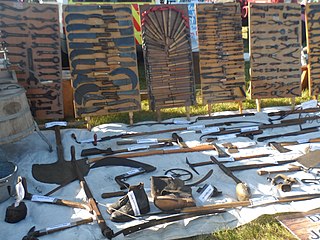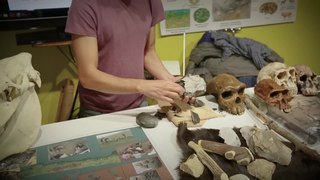A cleaver is a large knife.
Cleaver or Cleavers may also refer to:
Mode may refer to:
Punt or punting may refer to:
Rock most often refers to:
A square is a regular quadrilateral with four equal sides and four right angles.

A tool is an object that can extend an individual's ability to modify features of the surrounding environment. Although many animals use simple tools, only human beings, whose use of stone tools dates back hundreds of millennia, have been observed using tools to make other tools. Early tools, made of such materials as stone, bone, and wood, were used for preparation of food, hunting, manufacture of weapons, and working of materials to produce clothing and useful artifacts. The development of metalworking made additional types of tools possible. Harnessing energy sources such as animal power, wind, or steam, allowed increasingly complex tools to produce an even larger range of items, with the Industrial Revolution marking an marked inflection point in the use of tools. The introduction of automation allowed tools to operate with minimal human supervision, further increasing the productivity of human labor.
The words Celt and Celtic may refer to:
Whetstone may refer to:
Blank or Blanks may refer to:
Ward may refer to:
Chopper may refer to:

A hand axe is a prehistoric stone tool with two faces that is the longest-used tool in human history, yet there is no academic consensus on what they were used for. It is usually made from flint or chert. It is characteristic of the lower Acheulean and middle Palaeolithic (Mousterian) periods, roughly 1.6 million years ago to about 100,000 years ago, and used by homo erectus and other early humans, but rarely homo sapiens Its technical name (biface) comes from the fact that the archetypical model is a generally bifacial and almond-shaped (amygdaloidal) lithic flake. Hand axes tend to be symmetrical along their longitudinal axis and formed by pressure or percussion. The most common hand axes have a pointed end and rounded base, which gives them their characteristic almond shape, and both faces have been knapped to remove the natural cortex, at least partially. Hand axes are a type of the somewhat wider biface group of two-faced tools or weapons.

In the archaeology of the Stone Age, an industry or technocomplex is a typological classification of stone tools.
A screw is an externally threaded fastener. "Screw" or "screws" may also refer to:
STC may refer to:
A quarry is a type of mine, usually open-cast, generally for the extraction of stone such as for building or fossil fuel.
Scrape, scraper or scraping may refer to:

A butcher knife or butcher's knife is a knife designed and used primarily for the butchering or dressing of animal carcasses.

In archaeology, a cleaver is a type of biface stone tool of the Lower Palaeolithic.
Burin may refer to:
Bambata Cave is one of the Southern Africa prehistoric sites situated in Motobo National Park along with Inanke, Nswatugi, Pomengwe and Silozwane caves in Zimbabwe.